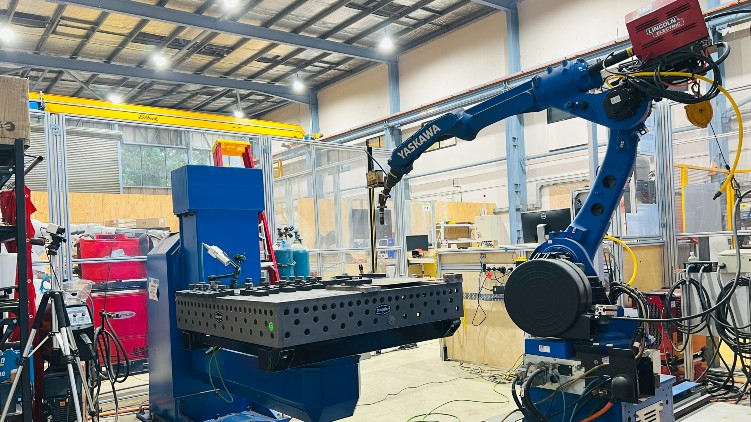October 1, 2025
Role of Additive Manufacturing and Hardfacing Innovations in a Modern Steel Industry
Additive manufacturing is changing how industries approach the repair and production of steel components, offering faster, more efficient, and cost-effective solutions. At its core, additive manufacturing involves depositing material in layers.
In Project 2.1.6 “Additive Manufacturing of Welded Overlay” in the Steel Research Hub, this principle is applied through robotic welding to investigate the deposition of commercial iron-based high-chromium carbide hardfacing alloys on thin, high-strength Quench and Tempered (Q&T) steel substrates using the gas-metal arc welding process.
Hardfacing is typically applied in only a few additive layers, but its advantages are substantial. A hardfaced steel product gains a hard, wear-resistant surface, extending its service life. More importantly, the hardfacing layer can be applied not only to new components but also to damaged ones, making it a repairable and sustainable option. These qualities make hardfacing valuable across industries such as mining, construction, agriculture, and railways, where equipment and protective materials are exposed to extreme wear and costly failures.
The project has focused on investigating two gas metal arc welding processes: the short-circuit arc transfer, which offers more heat-controlled deposition, and the globular arc transfer, which is more traditional. The goal has been to achieve high quality deposits while minimising heat effects to the underlying steel substrate. To evaluate performance, the developed plates were subjected to high velocity armour piercing projectile impacts. These tests demonstrated the potential of hardfaced steel plates to withstand significant impacts, while also highlighting the possible challenges of controlling distortion and thermal effects on high-strength steels. Addressing these challenges is key to advancing steels that combine strength, protection, and repairability.
The value of hardfacing: protection and repairability
For small and medium-sized enterprises (SMEs), these developments hold real promise. Hardfacing is already a well-established practice across industries such as mining and agriculture, valued for its ability to extend the life of components and reduce replacement costs. What this project adds is a new understanding of how advanced welding-based additive manufacturing can be applied, especially to thin high-strength Q&T steels, to overcome challenges such as distortion and thermal damage. The research provides a pathway towards the development of hardfaced Q&T steel plates that will not only be tougher and protective, but also repairable and reusable - outcomes that could offer practical benefits to Australian businesses, from established heavy industries to emerging defence applications.
Additionally, integrating robotics and automation in this process has the potential to significantly improve productivity, consistency, and quality. This approach supports national strategies aimed at enhancing manufacturing competitiveness and addressing labour shortages, providing SMEs with the tools to enhance efficiency while remaining globally competitive.
